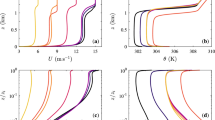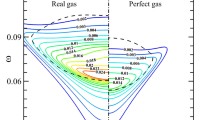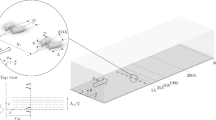Abstract
The present work introduces a means of forcing bypass transition within a zero-pressure-gradient smooth flat-plate boundary layer (ZPGSFPBL), suitable for DNS or LES computations for reproducing experimental datasets. In this type of bypass transition, one of the means of forcing transition within the boundary layer is via the introduction of a specific disturbance along the inflow boundary. Following this principle, the current method, introduces synthetic turbulence, generated by the method of Klein et al. (J. Comput. Phys. 186(2), 652–665, 2003), at the inflow, a certain height above the boundary layer, thereby confining it within the freestream. The principle parameter which dictates the transition behaviour is the height above the boundary layer at which the freestream turbulence is injected. By adjusting this parameter, as well as the integral length-scale and the intensity (either estimated or known a priori from experiments), ILES computations providing good agreement with experimental data sets can be achieved upon a variety of grids. This procedure has been validated upon the ERCOFTAC T3A experimental test case (freestream turbulent intensity of 3%), where good matching is achieved on streamwise quantities like skin-friction coefficient, shape factor, boundary layer thickness and fluctuating velocity growth rates as well as for profiles of mean velocity and fluctuating velocities in the wall-normal direction.












Similar content being viewed by others
References
Andersson, P., Berggren, M., Henningson, D.S.: Optimal disturbances and bypass transition in boundary layers. Phys. Fluids 11(1), 134–150 (1999)
Arnold, D.N.: An interior penalty finite element method with discontinuous elements. SIAM J. Numer. Anal. 19(4), 742–760 (1982)
Brandt, L., Schlatter, P., Henningson, D.S.: Transition in boundary layers subject to free-stream turbulence. J. Fluid Mech. 517, 167–198 (2004)
Calo, V.M.: Residual-Based Multiscale Turbulence Modeling: Finite Volume Simulations of Bypass Transition. Ph.D. thesis, Stanford University, USA (2004)
Chapelier, J.B., Lodato, G., Jameson, A.: A study on the numerical dissipation of the spectral difference method for freely decaying and wall-bounded turbulence. Comput. Fluids 139, 261–280 (2016)
Coull, J.D., Hodson, H.P.: Unsteady boundary-layer transition in low-pressure turbines. J. Fluid Mech. 681, 370–410 (2011)
Ducros, F., Comte, P., Lesieur, M.: Large-eddy simulation of transition to turbulence in a boundary layer developing spatially over a flat plate. J. Fluid Mech. 326, 1–36 (1996)
Fransson, J.H., Matsubara, M., Alfredsson, P.H.: Transition induced by free-stream turbulence. J. Fluid Mech. 527, 1–25 (2005)
Grosch, C.E., Salwen, H.: The continuous spectrum of the Orr-Sommerfeld equation. part 1. the spectrum and the eigenfunctions. J. Fluid Mech. 87(1), 33–54 (1978)
Harten, A., Hyman, J.M.: Self adjusting grid methods for one-dimensional hyperbolic conservation laws. J. Comput. Phys. 50(2), 235–269 (1983)
Jacobs, R.G., Durbin, P.A.: Shear sheltering and the continuous spectrum of the Orr-Sommerfeld equation. Phys. Fluids 10(8), 2006–2011 (1998)
Jacobs, R., Durbin, P.: Simulations of bypass transition. J. Fluid Mech. 428, 185–212 (2001)
Jameson, A.: A proof of the stability of the spectral difference method for all orders of accuracy. J. Sci. Comput. 45(1-3), 348–358 (2010)
Johnson, M.W., Ercan, A.H.: A physical model for bypass transition. Int. J. Heat Fluid Flow 20(2), 95–104 (1999)
Jonáš, P., Mazur, O., Uruba, V.: On the receptivity of the by-pass transition to the length scale of the outer stream turbulence. Eur. J. Mech.-B/Fluids 19(5), 707–722 (2000)
Kempf, A., Wysocki, S., Pettit, M.: An efficient, parallel low-storage implementation of Klein’s turbulence generator for LES and DNS. Comput. Fluids 60, 58–60 (2012)
Ketterl, S., Klein, M.: A band-width filtered forcing based generation of turbulent inflow data for direct numerical or large eddy simulations and its application to primary breakup of liquid jets. Flow Turbul. Combust. 101(2), 413–432 (2018)
Klebanoff, P.: Effect of Free-Stream Turbulence on a Laminar Boundary Layer. Bullet. Amer. Phys. Soc. 16(11), 1323–+ (1971). Amer Inst Physics 1305 Walt Whitman Rd, Ste 300, Melville, NY 11747-4501 USA
Klein, M., Sadiki, A., Janicka, J.: A digital filter based generation of inflow data for spatially developing direct numerical or large eddy simulations. J. Comput. Phys. 186(2), 652–665 (2003)
Kopriva, D.A.: A conservative staggered-grid Chebyshev multidomain method for compressible flows. II. A semi-structured method. J. Comput. Phys. 128(2), 475–488 (1996)
Kopriva, D.A., Kolias, J.H.: A conservative staggered-grid Chebyshev multidomain method for compressible flows. J. Comput. Phys. 125(1), 244–261 (1996)
Lardeau, S., Leschziner, M., Zaki, T.: Large eddy simulation of transitional separated flow over a flat plate and a compressor blade. Flow Turbul. Combust. 88 (1-2), 19–44 (2012)
Liu, Y., Vinokur, M., Wang, Z.: Spectral difference method for unstructured grids i: basic formulation. J. Comput. Phys. 216(2), 780–801 (2006)
Lund, T.S., Wu, X., Squires, K.D.: Generation of turbulent inflow data for spatially-developing boundary layer simulations. J. Comput. Phys. 140(2), 233–258 (1998)
Matsubara, M., Alfredsson, P.H.: Disturbance growth in boundary layers subjected to free-stream turbulence. J. Fluid Mech. 430, 149–168 (2001)
Morkovin, M.V.: Bypass transition to turbulence and research desiderata. Tech. report, Illinois Inst. of Tech., Chicago (1985)
Nagarajan, S., Lele, S., Ferziger, J.: Leading-edge effects in bypass transition. J. Fluid Mech. 572, 471–504 (2007)
Ovchinnikov, V., Choudhari, M.M., Piomelli, U.: Numerical simulations of boundary-layer bypass transition due to high-amplitude free-stream turbulence. J. Fluid Mech. 613, 135–169 (2008)
Pinto, B., Lodato, G.: Large-eddy simulation of bypass transition using the spectral-element dynamic model. Flow, turbulence and combustion. In preparation (2018)
Rai, M.M., Moin, P.: Direct numerical simulation of transition and turbulence in a spatially evolving boundary layer. J. Comput. Phys. 109(2), 169–192 (1993)
Rao, V.N., Tucker, P., Jefferson-Loveday, R., Coull, J.: Large eddy simulations in low-pressure turbines: effect of wakes at elevated free-stream turbulence. Int. J. Heat Fluid Flow 43, 85–95 (2013)
Roach, P., Brierley, D.: The influence of a turbulent freestream on zero pressure gradient transitional boundary layer developement including the condition test cases T3A and T3B (1992)
Roe, P.L.: Approximate riemann solvers, parameter vectors, and difference schemes. J. Comput. Phys. 43(2), 357–372 (1981)
Rogallo, R.S.: Numerical experiments in homogeneous turbulence. Tech. report, NASA Ames Research Center, Moffett Field (1981)
Schubauer, G.B., Skramstad, H.K.: Laminar-boundary-layer oscillations and transition on a flat plate. Tech. report, National Aeronautics and Space Administration, Washington (1948)
Shahbazi, K.: An explicit expression for the penalty parameter of the interior penalty method. J. Comput. Phys. 205(2), 401–407 (2005)
Sun, Y., Wang, Z.J., Liu, Y.: High-order multidomain spectral difference method for the Navier-Stokes equations on unstructured hexahedral grids. Commun. Comput. Phys. 2(2), 310–333 (2007)
Tomkins, C.D., Adrian, R.J.: Spanwise structure and scale growth in turbulent boundary layers. J. Fluid Mech. 490, 37–74 (2003)
Voke, P.R., Yang, Z.: Numerical study of bypass transition. Phys. Fluids 7 (9), 2256–2264 (1995)
Wang, Z., Liu, Y., May, G., Jameson, A.: Spectral difference method for unstructured grids II: extension to the euler equations. J. Sci. Comput. 32(1), 45–71 (2007)
Wissink, J., Rodi, W.: DNS of a Laminar Separation Bubble Affected by Free-Stream Disturbances. In: Direct and Large-Eddy Simulation V, pp. 213–220. Springer (2004)
Wu, X.: Inflow turbulence generation methods. Annu. Rev. Fluid Mech. 49, 23–49 (2017)
Wu, X., Moin, P.: Direct numerical simulation of turbulence in a nominally zero-pressure-gradient flat-plate boundary layer. J. Fluid Mech. 630, 5–41 (2009)
Xu, Z., Zhao, Q., Lin, Q., Xu, J.: Large eddy simulation on the effect of free-stream turbulence on bypass transition. Int. J. Heat Fluid Flow 54, 131–142 (2015)
Acknowledgements
The use of the SD solver originally developed by Antony Jameson’s group at Stanford University is gratefully acknowledged. This work was granted access to the HPC resources of IDRIS-CNRS under the allocation i2016-2a7361 made by GENCI (Grand Equipement National de Calcul Intensif). The Haute Normandie Computing center CRIANN is also acknowledged.
Funding
Financial support to the first author was provided within the framework of the BIOENGINE Project through the European Funds of Regional Development (FEDER) under grant number HN0002485. Financial support to the second author was provided by ANR under grant number ANR-14-CE05-0029 and FRAE under grant number 14-CE05-0029-FN.
Author information
Authors and Affiliations
Corresponding author
Ethics declarations
Conflict of interests
The authors declare that they have no conflict of interest.
Additional information
Publisher’s Note
Springer Nature remains neutral with regard to jurisdictional claims in published maps and institutional affiliations.
Rights and permissions
About this article
Cite this article
Pinto, B., Lodato, G. Synthetic Freestream Disturbance for the Numerical Reproduction of Experimental Zero-Pressure-Gradient Bypass Transition Test Cases. Flow Turbulence Combust 103, 25–54 (2019). https://doi.org/10.1007/s10494-018-0004-6
Received:
Accepted:
Published:
Issue Date:
DOI: https://doi.org/10.1007/s10494-018-0004-6




